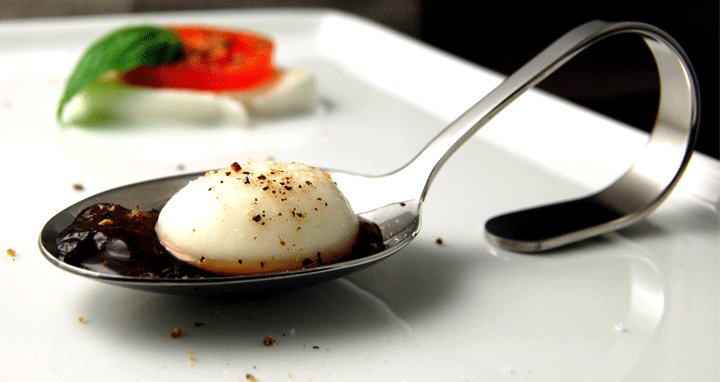10 Tips to Create a Perfect Sphere
Getting started with the spherification technique created by Ferran Adria at el Bulli is not difficult but creating a perfect sphere shape requires some practice. These are a few tips to help you master the spherification technique and impress your diners with a perfect sphere.
1- Get the right viscosity. The difference in viscosity between the flavored solution and the bath affects how easy is to form a sphere with basic and reverse spherification. The sphere shape forms due to surface tension between the liquids. The general rule is that it is easier to form a sphere if the flavored solution is thicker (more dense) and the bath is thinner (less dense).
-In basic spherification try adding more sodium alginate to the main ingredient if its spreading in the bath and not holding its shape. Keep in mind that the eating experience will be better if the liquid inside the sphere is less dense so don’t add too much sodium alginate. If the spheres sink too fast and flatten in the bottom, you can constantly stir the bath so the spheres float around or add sugar to it to increase the viscosity.
-In reverse spherification try adding xanthan gum to the main ingredient or in some cases even reducing the amount of sodium alginate in the bath helps. Keep in mind that the eating experience will be better if the liquid inside the sphere is less dense so don’t add too much xanthan gum.

2- Do not use tap water. If the calcium content of your tap water is high, it will thicken the sodium alginate bath when doing reverse spherification as the calcium will trigger the jellification process. And a thicker bath will make the spherification process more difficult. Use distilled water instead. Not mineral water since it can also contain calcium.
3- Use a spherical spoon. For preparations other than caviar in which you use a syringe, use measuring spoons with a spherical shape. These help get a better spherical shape when pouring the main ingredient into the bath, they conveniently come in different sizes to create ravioli, gnocchi, etc and are included in the Molecular Gastronomy Essentials Kit, the Molecular Gastronomy Premium Kit and the Molecular Gastronomy Ultimate Kit.
4- Use a flat pan for the bath. This is especially important for reverse spherification because the spheres tend to stick together if they become in contact with each other. If you use a bowl, it will be harder to keep the spheres separate as they will all flow into the middle of it as you pour the main ingredient into the bath to create multiple spheres.
5- Fill the bath container up to the top. If you fill the container not less than an inch from the top, it will be easier for you to place the pouring spoon almost horizontally touching the liquid for an easy and smooth pouring with the twist of your wrist. Otherwise, the container sides may be on your way not allowing you to hold the spoon horizontally close to the surface of the liquid.
6- Pour the liquid carefully. This is the most critical step in spherification and it requires practice. There are a few ways of doing this and some techniques work better for some people. Be patient and try different things until you find the right process for your preparation.
- Don’t pour the main ingredient from high above the surface of the bath. The impact of the liquid on the surface of the bath will flatten the sphere. Place your spoon horizontally close to the bath surface or even touching it and, with a fast but gentle twist of your wrist, pour the liquid into the bath.
- Another technique is to place the spherical spoon in the bath and with a syringe, inject the liquid in the bath in the spoon cavity to help form the sphere. When mastered, this technique allows you to create spheres a little faster since you don’t need to go back and forth between the bath and the main ingredient container while cleaning the spoon in between.
7- Don’t let the spheres float at the top. After pouring the sphere into the bath, sometimes they stay floating. You don’t want this to happen because the top won’t get much exposure to the bath solution and it won’t gel and form a sphere. To make the sphere sink in the bath, gently create a few waves in the bath around the sphere using a spoon or your fingers so that the bath solution gets on top of the sphere. This will also help form the sphere shape as the floating edges of the sphere fold into the center of it.
8- Flip the spheres occasionally while in the bath. If they stay touching the bottom of the recipient, the bottom of the spheres will be less in contact with the bath resulting in a thinner membrane than the rest of the sphere which could break easily. This side of the sphere will also be somewhat flattened.
9- Clean your spoons. Always wipe your spherical spoon after each pour, especially if you are placing the spoon bottom on the bath to pour the liquid. Also make sure your slotted spoon is clean before you dip it in the bath to fish your spheres. If you don’t clean your spoons, you may get small lumps of extra gel or “baby” spheres stuck to your sphere.
10- Keep the bath clean. If a sphere breaks in the bath and there are small particles floating around, pass the bath solution through a sieve and continue the spherification process with a clean bath to avoid these particles from sticking to your sphere.





